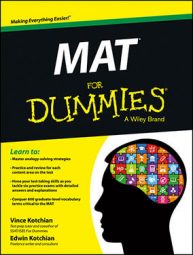If you don’t know the words used in an MAT analogy, it can be hard to solve. Still, there are several techniques you can use to select the right answer, including working backwards.
Not recognizing the words used in an MAT analogy may affect your ability to recognize whether the analogy is 1:2,3:4 or 1:3,2:4. It may also affect your ability to build a sentence that defines the relationship between the known terms. Both of these things may prevent you from choosing the right answer to an analogy.
Unless you’re sure or pretty sure what an analogy term means, don’t use its meaning to help figure out a sentence or even an analogy’s structural type.
When you don’t know the words used in an MAT analogy, you can use the process of elimination (using the terms you do recognize) to arrive at a best-guess. You can also make an educated guess based on the difficulty level of the analogy. Finally, you may find it helpful to work backward to solve the analogy.
Where the analogy appears in the test matters when trying to figure out an analogy’s difficulty level: Easy questions appear early in the test, while the questions at the end are the hardest to answer. Also remember that easy questions have more obvious answers; harder questions have less obvious answers.
Consider the following analogy.
(Mystery term) : HORSE :: CUB : _________________
(A)zebra
(B)giraffe
(C)dog
(D)lion
Here, the phrase “mystery term” represents a term you don’t know. But even though you don’t know the first term, you may notice that you can make a clear relationship between cub and Choice (D), lion, since a cub is a baby lion. Now you may realize that the analogy is 1:2,3:4 and be able to guess that the “mystery term” probably means a baby horse.
In this analogy, you’d probably be even more confident you had the right answer if it appeared in the first third of the test (questions 1–40) because easier questions — questions that most test takers answered correctly — appear earlier.
Here’s another example of working backward when you don’t know either of the first two terms.
(Mystery term) : (Mystery term) :: SMART : _________________
(A)hurt
(B)intelligent
(C)confused
(D)brief
Obviously, not knowing two of the terms in an analogy can make answering it tricky. But you can still take an educated guess.
First, think about whether the analogy is 1:2,3:4 or 1:3,2:4. Since both the first and second terms are missing, it’s impossible to confirm that the analogy is 1:3,2:4. The only option is to try to make a workable 1:2,3:4 analogy.
Now consider difficulty level. If this analogy appeared early in the test, it would probably make sense to guess Choice (B), reasoning that you could build a sentence like “Smart means intelligent.”
If the analogy appeared later in the test, you would probably want to avoid picking Choice (B) — it’s too obvious. Instead, you could surmise that most students missed the question because the test writers used a secondary definition of a word, and you could build the sentence “To smart means to hurt” and pick Choice (A).
The MAT writers sometimes choose words with secondary, or less common, meanings, so be on the alert for secondary meanings, especially when trying to guess.

